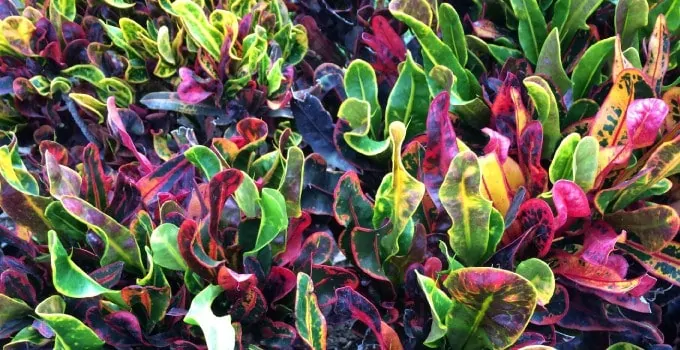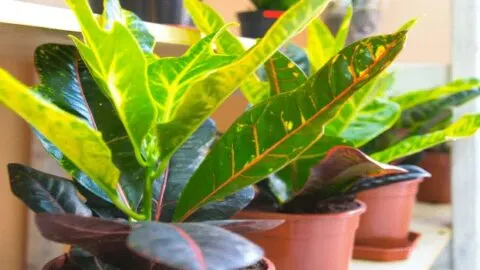Croton, aka Codiaeum variegatum var. Pictum, is a tropical plant native to Sri Lanka.
It should therefore not come as a surprise, that Croton plants thrive best in high humidity environments.
On top of that, Codiaeum variegatum is most comfortable in high temperatures.
If you fail to provide these two key elements, your plant will be in deep trouble. Crotons are little divas and they are not very forgiving if you are not giving them the care that they ask for.
So, it needs to be said at this point that Croton plants are not very suitable for beginners.
To make sure that you provide your Croton with the best care possible, please take our Croton plant care tips to heart, so that you’ll see your colorful friend thriving and prosper!

Table of Contents
Croton Plant Care Basics
Soil
Luckily, Crotons are not particularly fussy about soil.
Generally speaking, Croton plants do best in rich, well-draining soil.
Crotons feel comfortable in neutral soil, which is soil with a pH level between 6.6 and 7.3. If you are unsure about soil pH, you can use a soil meter to determine the pH level.
Alternatively, Crotons can also be well cultivated in hydroponics. Optimal water storage is easier when kept in hydroponics.
If you do indeed want to change over to hydroponics, remove the soil completely, wash the roots thoroughly and do not change the location for the first few months after the switch.
Light
Croton likes a good amount of bright, indirect light. A certain amount of direct sunlight can be beneficial for your Croton, however, it can also lead to burned leaves.
In summer, make sure not to expose your Croton to the burning midday sun.
Watering
Croton plants are in favor of quite a lot of water. It is, therefore, best to keep the compost moist. Waterlogging needs to be avoided.
Make sure to water your Croton thoroughly when the surface of the soil feels dry.
Tap water can be used for crotons (if you do use it, make sure it is not cold!), but lime-free water or distilled water is the preferred choice.
Temperature
Croton thrives well at room temperature (18 to 24 degrees/64.4 to 75.2 °F).
In winter, make sure that your Croton is not exposed to temperatures below 13 °C (55.4°F).
As is true with many other houseplants, Crotons do not respond well to sudden changes in temperature. In fact, this could even be fatal for your plant.
Humidity
Native to the tropics of Sri Lanka, this plant prefers high humidity. By simply keeping this plant in your home, be it in the kitchen or the living room, you will most certainly not reach the desired humidity level.
To increase the humidity, make sure to mist your plant regularly. Especially in summer, it definitely can’t hurt to mist your plant on a daily basis.
Other proven ways to increase the overall humidity for your Croton is to place is on a trey with damp pebbles.
Also, it would do your Croton good to have some other houseplants close by. This, too, will help in further increasing the humidity.
Last but not least, you would want to choose a room in your home that provides your Croton with a good amount of humidity “out of the box.” The bathroom usually fits this criterion.
However, don’t forget that your Codiaeum needs a good amount of sunlight to survive. Many bathrooms might be far from ideal in this regard.
During growing season, feed your Croton twice a week with liquid fertilizer.
In winter, fertilizing your Croton isn’t necessary.
Propagation
Croton is best propagated through stem cuttings. Propagation by air layering is also possible.
Growth
The croton is an evergreen and upright growing shrub that can grow up to two meters high (up to 6.5 feet).
(Re)potting
In order for a Croton to thrive well, the choice of the right plant pot is important. Make sure to choose a pot that meets the following criteria:
- Choose a pot that is large enough to accommodate all the roots and allows them to spread well
- Choose a pot with drainage holes
Repot your Croton when it outgrows its pot. As usual, repotting ist best done in spring. When repotting, it is advised to keep the same compost.
Also, it is best to leave your plant at the same location after repotting, as Crotons are very susceptible to change as far as the location and also the humidity (temperature) goes.
Croton propagation techniques
Crotons are best propagated through stem cuttings.
Make sure to follow these easy steps to create Croton plant babies:
Step 1: Search your Croton for healthy stems.
Step 2: Use a sharp, sterile knife to proceed with the cuttings
Step 3: The cuttings need to be done directly below the leaf node (cuttings of about 10 to 15 cm)
Step 4: Dip the freshly made cutting in a rooting hormone.
Step 5: Then, put the cuttings in a glass of water. Make sure to use soft water for that purpose.
Step 6: Change the water regularly. Once every two days or even once a day will yield the best results.
Step 7: As soon as the first roots show and new leaves can be seen at the top, you can put the cutting in soil.
Please note: It will take about 4 weeks for your cuttings to root. Instead of putting the cuttings in water, you can also put them in soil immediately. If you choose to do just that, make sure that the (soil) temperature is around 30 degrees. Also, high humidity is essential.

Crotons come in all kinds of colors and patterns. Only the species Codiaeum variegatum var. Pictum is cultivated as a houseplant but this species alone is very diverse and features plants with very colorful foliage, be it black, green, yellow, red, silver and many other colors.
Croton: Pruning practices
Do you even need to prune your Croton?
Well, it depends.
Usually, Crotons develop pretty well and become bushy even without some pruning help. After all, the Croton grows very slowly. Regular pruning is, therefore often not necessary. If the plant does get too big, though, pruning won’t hurt.
Please wear gloves when doing so, as the Croton is toxic (toxic juice).
Pruning is best done in early spring.
Croton SOS
Problem: Leaves go brown or drop off
Cause: Brown leaves or leaves that drop off are usually a sign that your Croton does not get enough water.
Remedy: Increase watering your Codiaeum variegatum var. Pictum.
Problem: Pale leaves
Cause: If your Croton features pale leaves, chances are that it gets (too much) direct sunlight.
Remedy: Either take your Croton completely out of direct sunlight or make sure that it receives less direct sunlight. In summer, make sure that your Croton is not exposed to midday sun. In summer, Midday sun is not well received by Croton.
Problem: Wilting, brown leave tips
Cause: Not enough humidity.
Remedy: Increase the humidity level. The easiest way to do that is by regularly misting your croton. If that is not enough, place your Croton on a bed of damp pebbles to further increase the humidity.

Not only do Crotons feature very striking, colorful foliage, but also do they come in many different shapes with all kinds of different leaf patterns.
Croton Plant Pests & Diseases
Mealybugs
There are a few possible causes for a mealybug infestation of your Croton. It might be that you have contaminated soil. Another reason for Mealybugs on your Croton could simply be that you recently expanded your urban jungle (bought a new plant) that already had mealybugs.
After all, these little creatures are not always that easy to see. So, when buying a new plant, one thing you should always double-check is whether the plant really is in good and healthy condition or not. Don’t forget to check for plant pests!
When dealing with mealybugs, the first thing you should do is to quarantine your Croton to prevent these creatures from spreading to other houseplants. Once that is done, wipe off the mealybugs with a damp cloth or cotton bud soaked in alcohol. Another remedy that many members of our Houseplant FB group swear by to get rid of mealybugs is the use of Neem oil.
Thrips
One problem with pests is that they must first be detected and correctly identified. And more often than not, that is not an easy task, as many of these pests are really small and can hardly be identified properly without a magnifying glass or a hand lens.
If you do spot straw-colored, slender insects with two pairs of wings, you are likely dealing with thrips.
Indicators for a thrips infestation are, among others:
- Pale leaves
- Silvery streaks on leaves
- Black fecal matter on the leaves
- Discoloration (due to injury)
There are a lot of different thrips species out there, all of which could be sucking the life out of your houseplant.
Now, as far as thrips pest management goes, there are a couple of things you can do to get rid of these little pests.
Insecticidial soap is a good control measure for thrips. Make sure to spray the infested plant regularly and apply the soap to all infested parts of the plant (don’t forget the undersides of the leaves, tips, etc.).
Oil sprays are also a proven way to get rid of thrips. Here again, same as with mealybugs, you can use neem oil to get rid of these persistent pests.
Spider Mites
Crotons are very prone to Spider Mites attacks.
Telltales of a spider mite infestation (on Crotons or any other houseplant) are small webs, yellow streaks and yellow patches on leaves.
A great trick is to put a sheet of paper underneath a plant and shake on the leaves. The spider mites will come right off. If the infestation gets really bad, whole leaves can start to fall off your Croton.
In most cases, simply shaking off the spider mites won’t be enough, though. You will need to take more dramatic measures to ridden your plant of this stubborn plant pest.
Here’s what you can do to get rid of spider mites for good:
- Wash your Croton including leaves and stems off every day with a sponge or wet cloth
- Use a cotton swab with rubbing alcohol as this will kill the mites
- Get rid of already infested leaves and trash them
- Use running water to wash Spider Mites away
- Use predatory mites that prey on Spider Mites such as Lady Bugs
- Apply an oil spray (e. g. neem oil) on your Croton
In some cases, however, it might be too late to save your plant from these nasty little creatures. If your whole Croton is badly infested, you might need to get rid of your colorful leafy friend. Adieu!
Plant diseases
As far as plant diseases go, Crotons are largely spared. If you are overwatering your Croton, you might deal with root rot at some point.
But don’t worry. We got two very informative articles about the subject that will help you out in that case:
Root Rot Causes & Symtpoms you wish you knew earlier
5 tips to keep your Croton happy
- Keep the humidity high
- Crotons like a good amount of direct light
- Keep your Croton away from drafts
- Avoid temperatures below 13 degrees
- Crotons are very susceptible to change (location, temperature, etc.). Keep in the same place whenever possible.
Is Croton easy to care for?
Croton care is moderately difficult. While some plant parents find it pretty easy to provide their Joseph’s Coat with the right care, others hardly manage to keep it alive.
Since the Croton is a tropical plant, you must provide the plant with high humidity to ensure that it stays healthy and thrives as expected.
Apart from that, warm temperatures are equally crucial for the well-being of your colorful companion.
If you are not an experienced plant parent just yet, or maybe even have a black thumb (don’t worry, we all started like that), you might want to go with something a little bit easier, such Spider plants, Peace Lilies, Snake plants or Pothos.
Croton FAQ
When is the best time to propagate Crotons?
Croton is best propagated in early spring. January, February or March are, therefore, ideal months to propagate your Codiaeum.
What is the botanical name of Croton?
The botanical name of Croton is Codiaeum variegatum.
What are some other names for Codiaeum variegatum?
Codiaeum variegatum is also known as Joseph’s Coat, garden croton and variegated croton.
My Croton is not growing anymore, what’s wrong?
First of all, it needs to be said that Crotons grow very slowly. If it grows slower (than before), it might be that the temperature is too low. Crotons won’t grow properly when temperatures drop below 65°F (about 18 degrees °C).
Is it ok to use terracotta pots for Crotons?
Terracotta pots are fine for Crotons. You might need to water your plant a little bit more than if you had it in a plastic pot.
Is tap water fine for Crotons?
Tap water may not be the best choice for Crotons (rainwater or distilled water is better!), but it is acceptable unless it is very hard. Don’t use cold water (water should be at room temperature when applied).
Is Croton safe for cats?
Croton contains toxic substances and is, therefore, not safe for cats. If you are looking for cat-safe houseplants, please have a look at our article: 18 Cat-Safe Houseplants that your kitties will surely enjoy.
Is Croton safe for dogs?
Croton contains toxic substances and is, therefore, not safe for dogs.
What are some nice varieties of Codiaeum variegatum var. Pictum?
There are many exciting cultivars of Codiaeum variegatum var. Pictum. For instance, there is Cadiaeum variegatum var. Pictum “Aucubifolium” with shining leaves and green spots, then there is Cadiaeum variegatum var. Pictum “Punctatum aureum” that comes with narrow, glossy leaves (green spotted with yellow).

Daniel has been a plant enthusiast for over 20 years. He owns hundreds of houseplants and prepares for the chili growing seasons yearly with great anticipation. His favorite plants are plant species in the Araceae family, such as Monstera, Philodendron, and Anthurium. He also loves gardening and is growing hot peppers, tomatoes, and many more vegetables.


